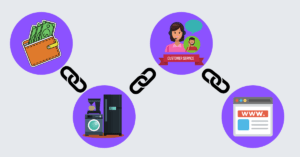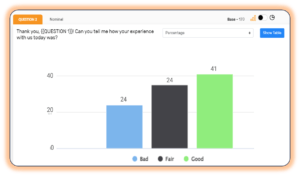Customer pain points are places that need the most focus. It could come at any point of the customer journey. Salespeople are the first in line to comprehend the obstacles and tackle customer reviews and grievances. So it becomes important to equip them with the right tools. In this blog, we will explore the 4 types of pain points and how to tackle the obstacles the right way.
What are Customer Pain Points?
Customer pain points refer to the specific challenges and problems that people encounter during their interaction with a product or service. Identifying and resolving these pain points is essential for businesses to offer effective solutions and enhance customer satisfaction. Common pain points include slow response times, low product quality, complex user interfaces, and limited customization options. By understanding and addressing these pain points, businesses can improve their offerings, streamline processes, and cultivate strong customer relationships.
What are pain points in marketing?
Pain points in marketing are the specific challenges or problems that customers face and are looking for solutions to. They can range from physical discomfort to emotional frustrations or financial burdens. Identifying and addressing these pain points is essential for successful marketing. This allows businesses to create products and services that genuinely meet customer needs.

What are the 4 types of Customer Pain Points?
The four types of customer pain points can fall under the financial, productivity, process, and support categories.
1. Financial factors
Customers often face financial pain points when it comes to the cost or price of a product or service. They may perceive a product as too expensive or feel that they are not getting enough value for their money. To address these concerns, businesses can offer discounts, promotions, or competitive pricing strategies. By highlighting the benefits and value of their offering, businesses can justify the price to customers. Additionally, providing payment options such as installment plans or financing can alleviate financial pain points.
2. Productivity factors
Customers often face productivity pain points that hinder their efficiency and effectiveness. These pain points can arise from slow processes, limited automation, inadequate access to tools or resources, and tasks that consume excessive time. To enhance the customer experience, businesses must identify and address these challenges. By streamlining processes, implementing technology solutions, and offering personalized support, companies can help customers save time, increase productivity, and achieve their objectives seamlessly. Addressing productivity pain points should be a top priority for companies seeking to deliver exceptional customer service and build long-term customer relationships.
3. Process factors
Process pain points refer to the inefficiencies and difficulties that customers face while going through the steps or processes of acquiring a product or service. Common pain points in this area include encountering long wait times, dealing with confusing or complicated procedures, or struggling with outdated systems. The best way to address process pain points is by streamlining and optimizing the customer journey, making it as seamless and efficient as possible. This can be achieved through the use of automation, simplifying procedures, and investing in technology that enhances the overall user experience. By addressing these specific pain points, businesses can significantly improve customer satisfaction and loyalty, leading to greater success.
4. Support factors
Support pain points encompass the challenges and frustrations that customers encounter while seeking help or support from a company. This also includes demonstrations for product usage (electronic appliances). The ultimate review reflects on the customer effort score reviews (CES score). These pain points may manifest as extended wait times, unhelpful customer service representatives, or difficulties accessing support channels. To alleviate these pain points, businesses should prioritize enhancing their customer service processes. Implementing efficient ticketing systems, offering multiple channels (such as customer support calls, email, and live chat), and ensuring well-trained customer service representatives can both improve the customer experience and resolve issues effectively.
How to Identify Customer Pain Points?
To identify customer pain points, gather feedback through surveys or interviews, monitor social media and review websites for customer reviews, analyze support tickets for recurring issues, and use data analytics tools to track behavior. This helps identify areas of frustration or dissatisfaction.
1. Survey and seek feedback
Engage with customers through surveys including net promoter score or NPS, customer satisfaction scores and social media listening to gather valuable customer feedback. This will give you an insight into their challenges and frustrations. Be sure to ask open-ended questions that encourage customers to share specific details about their problems. Through qualitative market research and customer feedback analysis, you can gain insight into common customer pain points and tailor your product or service accordingly. By addressing these pain points, you can enhance the customer journey, improve customer satisfaction, and ultimately drive better results.
2. Equip the sales team
Sales reps, being at the forefront of customer interactions, possess valuable insights into the challenges and frustrations customers experience. By encouraging open conversations, actively listening for recurring issues, and providing training and resources, your sales team can effectively identify and address grievances. Regularly gathering feedback from your sales team and incorporating their insights into product development and improvement efforts is vital for enhancing the overall customer experience.

3. Monitor online reviews and testimonials
Customers openly express their experiences and frustrations via reviews on social media sites of Facebook, Twitter or Google review. Through an in-depth analysis of online reviews, businesses can uncover recurring issues and common themes that customers face. Positive reviews shed light on features that customers truly value, while negative reviews point out areas that need improvement. By carefully examining the language and keywords used in each review, businesses can gain a complete understanding of the specific pain points customers encounter. This can help organisations detect detractors and convert them to promoters.
4. Closely watch your competitors
With every negative service, the customers have a choice to move to the competitors. Utilizing qualitative market research and leveraging feedback from prospective customers, you can identify common obstacles and integrate improvements into your own product offering. This approach ensures you are meeting the needs and expectations of your target audience, positioning your business as a top choice for customers facing specific problems or challenges.
How to Fix Customer Pain Points and Improve CX?
Organisations can deploy internal systems to collect prompt feedback, assess them in real time and curate better marketing strategies. It is not enough to curate strategies but also to focus on an overall customer experience. Here are some steps businesses can take for a better CX.

#1 Deploy a feedback management system:
Deploying a feedback management system is crucial in effectively addressing customer pain points. By collecting and analyzing customer feedback through surveys, customer reviews, and social media monitoring, businesses can identify common pain points and prioritize areas for improvement. This qualitative market research helps businesses gain insights into specific problem areas that may cause friction in the customer journey. Actively listening to customer feedback and promptly addressing their concerns demonstrates a commitment to improving the customer experience. Regular communication with customers about the steps being taken to alleviate their pain points further enhances transparency and customer satisfaction. Continuous monitoring and evaluation of the implemented solutions ensure ongoing refinement. Deploying a feedback management system is a top priority for businesses looking to leverage customer data and enhance their user experience.
#2 Optimize customer journeys:
Customer journey is a process where a customer starts as a potential customer and eventually moves to being a long-time patron. Mapping the customer journey at important touchpoints can bring vivid insights. This process involves analyzing touchpoints, such as website navigation, checkout processes, and support team communication, product/service usage etc. By continuously monitoring and gathering feedback from customers, businesses can ensure that changes effectively address their pain points. Merren can capture feedback at various touchpoints. To choose the right customer mapping tool, learn more here.
#3 Document common roadblocks:
One way to do this is through surveys, feedback forms, and customer interviews, which provide valuable qualitative research to uncover pain points. Analyzing customer support tickets and complaints also helps identify common pain points that require attention. This approach allows businesses to develop tailored solutions whether it’s streamlining the checkout process, improving communication, or enhancing product offerings. By regularly reviewing and updating this documentation, businesses can stay proactive in their efforts to address customers’ pain points, resulting in improved customer satisfaction and loyalty.
#4 Leverage using AI and automation:
Automation is a vital strategy for addressing and improving customer pain points. When internal teams can pin point of customer obstacles, businesses can implement automated solutions like customer relationship management systems or web based chatbots, which can automate tasks such as data entry or basic customer support. This saves time and allows employees to focus on more complex and personalized interactions with customers. Assess and ease data collection process using AI and keep it free of manual errors.
#5 Revisit your marketing strategy:
To enhance the overall customer experience, it is essential to reassess and optimize your marketing strategy. Begin by thoroughly identifying and comprehending your customers’ pain points through feedback, surveys, and data analysis. Armed with this knowledge, create a marketing approach that is specifically tailored to address these pain points and offer suitable solutions. Craft focused messaging and personalize content that effectively communicates how your product or service can be the right fit for your user base. Utilize powerful customer testimonials and relevant case studies to showcase how your offering has successfully mitigated similar pain points for other customers. Continuously monitor and evaluate the effectiveness of your marketing strategy in promptly addressing and resolving customer pain points while remaining adaptable to their evolving needs.
Conclusion
To truly succeed in business, it’s essential to address the pain points of your customers. By understanding their needs and challenges, you can develop strategies that not only solve their problems but also improve their overall experience with your brand. Whether it’s addressing financial struggles, increasing productivity, streamlining processes, or providing better support, taking steps to alleviate these pain points will lead to happier customers and increased loyalty.
You can now create your own Whatsapp surveys and add Whatsapp polls, survey questions using Merren. Sign up for a 14 day free trial with Merren or choose the right pricing plan that can fit your needs.

